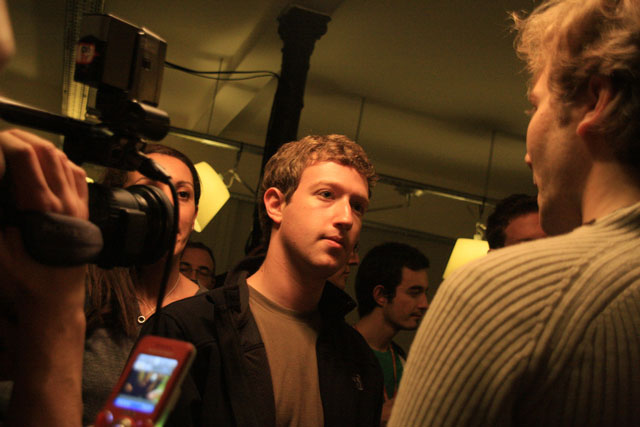 Mark Zuckerberg must be very accustomed to getting his way. When you’ve built two platforms with over a billion customers each (Facebook and Messenger), then acquired and grown another two to a similar size (Instagram and WhatsApp), you must be confident in your ability to spot a winning product. Why then, are all of Zuckerberg’s companies suddenly bending over backwards to imitate an upstart like Snapchat?
Mark Zuckerberg must be very accustomed to getting his way. When you’ve built two platforms with over a billion customers each (Facebook and Messenger), then acquired and grown another two to a similar size (Instagram and WhatsApp), you must be confident in your ability to spot a winning product. Why then, are all of Zuckerberg’s companies suddenly bending over backwards to imitate an upstart like Snapchat?
In the last few weeks, both WhatsApp and Facebook Messenger have launched new features that are uncannily similar to Snapchat’s functionality. WhatsApp has a newly upgraded “status” function that allows you to broadcast videos, slideshows and animations to your friends. These disappear after 24 hours — an unmistakeable hallmark of Snapchat’s offering.
Few people use WhatApp’s status function (or even know it exists), so the feature is largely irrelevant, but the changes to Messenger are much more substantial. In the markets where Facebook has launched the new feature, users are routinely prodded to broadcast images and videos to their “Messenger Day” — a shameless clone of Snapchat’s incredibly popular “stories” feature.
Many users are complaining that it gets in the way of what they use the app for — chatting to friends. Whenever you encounter a video or an image shared by a friend, you are repeatedly prodded to add it to your “Day”. If this sounds deeply annoying, that’s because it is.
If you hadn’t heard of Snapchat prior to its listing on the New York Stock Exchange earlier this month, there’s no need to feel embarrassed. According to the company’s disclosure documentation, the average Snapchat user is 18-24 years old and she lives in the US.
Zuckerberg’s eagerness to replicate Snapchat’s features is partly explained by its popularity with younger customers. They spend up to 30 minutes per day on the app, and send an average of 16 messages (called “snaps”). These numbers are compelling enough to value the company at over US$20bn. By comparison, the average Facebook user spends 50 minutes every day on a combination of Facebook, Instagram and Messenger.
When you’re as big as Facebook, you see any service that steals 30 minutes of user attention from you as a direct and even existential threat. Leisure time is a scarce resource, and one that is shared with dozens of other mediums and activities. Snapchat has around 160m daily users, and it is growing fast.
This hasn’t taken Zuckerberg by surprise. He recognised Snapchat as a threat years ago, and offered its founders $3bn in cash to sell him the company in late 2013. But, just as Zuckerberg himself rebuffed a $1bn offer from Yahoo in 2006, Snapchat’s founders declined. Both decisions look prescient now.
A large part of Snapchat’s appeal is its simplicity. Compared to a general purpose social network like Facebook, the service has very few features. You can chat with friends via short-lived, self-destructing messages (the feature which originally hooked privacy-obsessed teens) and you can publicly broadcast “stories” (a mix of videos, animations and photo galleries). That’s about it.

It’s almost impossible for Facebook to replicate this simplicity in its core offering. With nearly two billion users, Facebook is a broad church, catering to people of all ages and sophistication levels. Stripping even a minor feature out of the platform would cause tens or hundreds of millions of people to howl in outrage.
And so, Facebook has begun to tinker with its simpler, more focused services — trying to use them to woo Snapchat users. Its first attempt — Instagram Stories — has produced positive results. Launched in August 2016, the new video broadcasting feature has already attracted more than 150m users.
Even better, the feature appears to be hurting Snapchat’s numbers. Content creators who use Snapchat as a distribution channel are reporting substantial drops in audiences since the launch of Instagram Stories. This evidence is anecdotal and the causality isn’t at all clear, but it’s plausible that Instagram is siphoning away some of Snapchat’s audience.
This might explain why Zuckerberg has decided to cram Snapchat-like features into his other single-purpose products. If it works on Instagram, why not on WhatsApp or Messenger? The answer to that question is obvious to most users of those services: because it’s annoying and we don’t want it.
Instagram is primarily focused on publishing and consuming content. It’s a good fit for a broadcasting feature like Stories. WhatsApp and Messenger, by contrast, are communication utilities. Trying to shoehorn broadcasting into those platforms is not just annoying, it’s obstructive. When do you ever want to broadcast a private message? You can build a toaster that’s also a television, but why would anyone want to use that?
A large part of Facebook’s success has been built on trying many different features, keeping the ones that succeeded and discarding those that did not. In many ways, the massive social network is a laboratory for human preferences.
The changes to Messenger and WhatsApp make more sense in that context, but they are almost certainly doomed to fail. A more important question is, if Snapchat didn’t exist, would Facebook be polluting two of its most successful products with these ill-fitting changes?
At well over a decade old, Facebook is facing the classic dilemma of the established market leader. Its nearly two billion existing customers like its current offering, and changing that offering radically will displease them. But Zuckerberg knows that the new kid on the block will eat his lunch if his company doesn’t evolve with the times.
Henry Ford once allegedly said: “If I had asked people what they wanted, they would have said faster horses.” The quote may not be genuine, but the sentiment is well proven. Until customers have experienced something new, they do not know how useful it might be. But Messenger Day isn’t a Ford Model T – it’s more like a horse-drawn carriage with a built-in gramophone. — © 2017 NewsCentral Media




